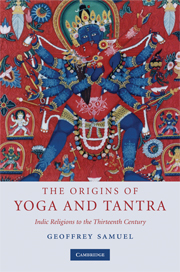Book contents
- Frontmatter
- Contents
- List of figures
- Preface
- 1 Introduction
- 2 Stories and sources
- PART ONE MEDITATION AND YOGA
- 3 The Second Urbanisation of South Asia
- 4 Two worlds and their interactions
- 5 Religion in the early states
- 6 The origins of the Buddhist and Jaina orders
- 7 The Brahmanical alternative
- 8 Interlude: Asceticism and celibacy in Indic religions
- PART TWO TANTRA
- References
- Index
6 - The origins of the Buddhist and Jaina orders
Published online by Cambridge University Press: 05 June 2012
- Frontmatter
- Contents
- List of figures
- Preface
- 1 Introduction
- 2 Stories and sources
- PART ONE MEDITATION AND YOGA
- 3 The Second Urbanisation of South Asia
- 4 Two worlds and their interactions
- 5 Religion in the early states
- 6 The origins of the Buddhist and Jaina orders
- 7 The Brahmanical alternative
- 8 Interlude: Asceticism and celibacy in Indic religions
- PART TWO TANTRA
- References
- Index
Summary
The origin of the renunciate orders in India, and particularly of monasticism, is one of the most intriguing and significant questions that arises in the study of Indic religions. The idea of asceticism leading to magical power is not uncommon in religions of tribal and pre-literate peoples. One might think here of the idea of vision quests among the Plains Indians, and of the ascetic practices associated with initiation into spirit-cults in many parts of the world. We might imagine, though we do not know for certain, that similar practices were common among preliterate societies in earlier periods. However, the idea of someone permanently committed to an ascetic state is much less common, and indeed since religious specialists in most preliterate societies are only part-time practitioners, it would scarcely be practicable. While there are plenty of examples in the ethnographic record of individuals who are regarded as having special powers and who may be set somewhat aside from the community as a whole and regarded with some suspicion as a consequence, these people normally make a living through hunting and gathering, pastoralism or farming like other members of their society.
As for monasticism, we know nothing much like the Buddhist and Jaina monastic traditions from elsewhere in the world before this date. Monasticism was in time to become an extremely important and influential institution within world culture, particularly in the Buddhist version, which spread through most of South, Southeast, Central and East Asia, and in the later Christian version.
- Type
- Chapter
- Information
- The Origins of Yoga and TantraIndic Religions to the Thirteenth Century, pp. 119 - 152Publisher: Cambridge University PressPrint publication year: 2008



